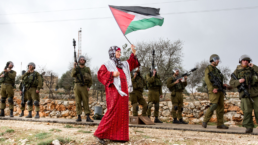The uneventful nature of structural violence renders it unfit for media coverage compared to kinetic violence. But the two are inextricably linked.
by Alexei Sisulu Abrahams, +972 Magazine
The violence unfolding across Palestine-Israel over the past four months has been accompanied by a near-real-time deluge of information on social and news media worldwide. As with other fast-moving, politically charged situations, a portion of that information has been false, and fact checkers have had their hands full. And as on other occasions, platforms such as Meta, Twitter/X, and even Telegram have been criticized for not intervening, or for intervening in a biased way.
Humans, however, do not formulate opinions based on information, but rather with stories spun from information — and the relationship between them is far from linear. Fictitious information can be arranged into a story that conveys profound truths, as great novelists have proven for centuries. Conversely, and as the past several months of coverage have demonstrated, there is no fact that cannot be indentured into the service of a lie. Beyond disinformation (trafficking falsehoods), I worry as a media researcher and longtime scholar of the Palestinian struggle that decontextualization (selectively presenting truths) is the more ubiquitous and elusive threat to our collective understanding.

Disinformation involves lying by commission, such as by asserting that the 2020 U.S. presidential elections were rigged against Trump, or that ivermectin cures COVID-19. Decontextualization, on the other hand, is all about lying by omission, and psychologists have shown that humans lie by omission with greater facility than by commission. Moreover, omission’s signature characteristic is absence — something humans are notoriously bad at noticing, which means we are liable to amplify decontextualized narratives unwittingly.
Recent Posts
‘Unconstitutional. Unethical. Authoritarian.’ ICE Bars Millions Of Immigrants From Bond Hearings
July 18, 2025
Take Action Now One watchdog said the new policy “seems like a blatant attempt to stop them from exercising their right to due process.”……
Americans Are Not Nearly Alarmed Enough About Climate Change
July 18, 2025
Take Action Now Americans still don’t comprehend how imminent, dangerous, and far-reaching the threat is—and journalists are partly to blame.By…
The IRS Is Building A Vast System To Share Millions Of Taxpayers’ Data With ICE
July 17, 2025
Take Action Now ProPublica has obtained the blueprint for the Trump administration’s unprecedented plan to turn over IRS records to Homeland Security…
Israel’s Sudden Assault On Syria Is Unchecked Aggression
July 17, 2025
Take Action Now Jerusalem is bombing Damascus and threatening al-Sharaa’s rule, while Washington was hoping to help the nascent government on…




